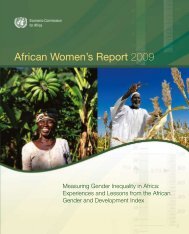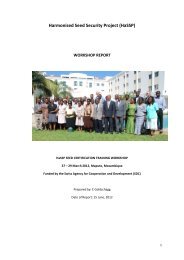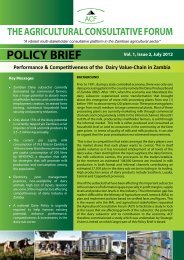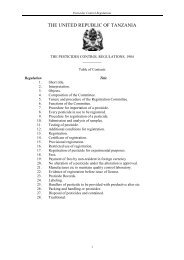Community-driven development decision tools for rural - IFAD
Community-driven development decision tools for rural - IFAD
Community-driven development decision tools for rural - IFAD
- No tags were found...
Create successful ePaper yourself
Turn your PDF publications into a flip-book with our unique Google optimized e-Paper software.
• regulations that govern <strong>decision</strong>s of the VA (including the election of the VDC);• procedures that must be followed to identify and prioritize the projects of interest to the VA.For CDD projects, work at the community level starts with the animation needed to establish therequired organizations and institutional setting.Organizations do not thrive in an operational vacuum. They only survive and develop if theyhave something to do which is useful <strong>for</strong> their members and if they can mobilize sufficientresources to actually do it. Externally funded projects that focus exclusively on building thecommunities’ “capacity to plan”, while relying on other sources <strong>for</strong> the resources to implementthe plans, are generally ineffective. Only very few plans get funded and so the capability andenergy mobilized around a plan are quickly lost.Accordingly, a CDD project must begin by communicating about what it can do <strong>for</strong> thecommunities and about the conditions the communities have to meet to establish a partnershipwith the project. To avoid losing momentum, the project should also be able to respond tocommunity requests without excessive delay.These are major undertakings that require the right calibre of animators and sufficient time <strong>for</strong>them to spend with their village partners. <strong>IFAD</strong>’s experience points to the need <strong>for</strong>• sufficient time and resources budgeted by the project <strong>for</strong> the initial animation work;• precise terms of reference (TORs) <strong>for</strong> the animation service providers that specify their tasksand objectives.For first-time CDD projects in an area, it is advisable to start with an initial phase of about 3years, during which the implementation arrangements, institutional setting and per<strong>for</strong>mance ofservice providers are tested and fine-tuned. This can be followed by a “scaling up” phase to coverthe entire area ultimately envisaged <strong>for</strong> the project. 37Prioritizing subprojectsIn an open-menu project, the communities’ demand is only limited by the list of activities thatthe project will not support and by the project’s specific criteria (e.g. the share of costs borneby the community, ceilings on the investment per community and per direct beneficiary,evidence of the community’s commitment and its willingness and capacity to supportoperations and maintenance). Projects with a lower CDD content direct the communities’demand towards predetermined areas of priority by restricting the menu of interventions fromwhich the communities may choose (e.g. irrigation, NRM and water supply, but not education,healthcare, marketing or transport infrastructure).In CDD projects, the animation service encourages the VDCsBox 30to implement the actions that do not require external resourcesThe risk of “excess”and to proceed in order of priority with the actions that doplanningrequire resources from the project. Initially, most VDCs submit a“Excess” planning generates long wish list and bargain with the project staff. This process lastsbureaucracy, even at theuntil the concept of effective demand is fully understood by thecommunity level, andcommunity. At that point, most communities realize that theybureaucrats always presenttheir bill <strong>for</strong> payment, in onecannot mobilize sufficient resources to undertake more than onecurrency or another,microproject every year. If people wish to conduct a project <strong>for</strong>increasing the risk of local more than one community (e.g. a local small water supplyelite capture.network or a minor irrigation scheme), the VDCs are encouragedto submit a joint request.37 This is an important lesson drawn from two projects: in the <strong>IFAD</strong> Umutara project in Rwanda, this initial phase of testing was notplanned and in a similar <strong>IFAD</strong> project in Cape Verde, the initial phase was planned and successfully conducted.64
















